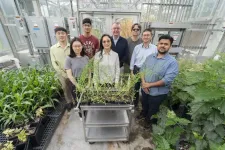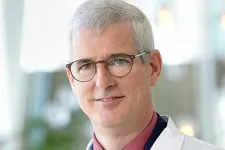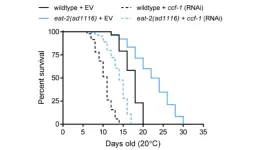(Press-News.org)
· Weakened virus helps eliminate melanoma and colon cancer in mice
· Therapy is effective in treating and even preventing cancer
· Virus raises ‘red flag’ on tumors so immune cells know to attack it
CHICAGO --- Northwestern Medicine scientists have discovered that an attenuated (weakened) virus can help eliminate cancer in mice. In addition, mice that were treated with this virus were more resistant to developing tumors later in life.
The attenuated virus — lymphocytic choriomeningitis virus (LCMV) — works and is safe even in immunosuppressed mice. That’s a critical finding, as many cancer patients undergoing chemotherapy and other cancer treatments have suppressed immune systems.
“An important aspect about this viral-based therapy is that it demonstrates safety and efficacy even in an immunosuppressed host,” said corresponding author Pablo Penaloza-MacMaster, an assistant professor of microbiology-immunology at Northwestern University Feinberg School of Medicine. “Mice that were devoid of their killer T cells and their B cells were nonetheless responsive to this therapy.”
The Northwestern scientists showed in multiple tumor models — including melanoma and colon cancer — that injecting tumor-bearing mice with this virus shrank the tumor and increased survival.
The study is published June 11 in The Journal of Clinical Investigation.
“LCMV induces a high immune response, but it can cause disease especially in transplant patients,” Penaloza-MacMaster said. “With molecular biology, however, it is possible to weaken this virus and render it attenuated for use as a safe therapy, while still being immunogenic. The other advantage is that it seems that the same LCMV therapy can be used for various types of cancer.”
Currently, so-called “oncolytic viruses” such as herpes are used to treat some types of cancer because of their ability to kill cancer cells. But these therapies are not effective with some tumors and their use poses safety concerns, especially in immunosuppressed patients, underscoring the need for safer alternatives, Penaloza-MacMaster said.
In addition to helping clear the tumors, the therapy also helped prevent future cancer in these mice. Healthy mice that were first treated with the LCMV therapy were more resistant to developing tumors later in life.
This phenomenon might be explained by a poorly understood biological process known as "trained immunity." Trained immunity occurs when a previous infection enhances the immune system's ability to respond to different diseases in the future. For example, studies have shown that children who received the tuberculosis (TB) vaccine exhibit improved protection against other microorganisms, not just TB. This differs from the typical vaccine response, such as with the SARS-CoV-2 vaccine, which primarily protects against this specific virus.
“Essentially, this therapy might be providing broader immune protection, helping the body to guard against different diseases beyond the original target,” said Penaloza-MacMaster, a member of the Robert H. Lurie Comprehensive Cancer Center of Northwestern University.
The next step in this research is to test the approach on dogs with sarcoma in collaboration with Dr. Seth Pollack, the Steven T. Rosen Professor of Cancer Biology at Feinberg and director of the Sarcoma Program at Lurie Cancer Center. If the dogs also show improvement, scientists hope to launch a clinical trial using the therapy with humans.
How does a virus treat cancer?
Tumors are skilled at evading the immune response by developing strategies to keep the immune system away from the tumor. Injecting the virus into the tumor raises the equivalent of red flags on the tumor to alert the immune system that there is an intruder.
The immunosuppressed mice had no T cells, B cells or macrophages (key immune cells). Despite the absence of these crucial immune cells, the virus was able to activate alternative immune pathways to fight the cancer. One way it did this was through interferons — molecules that signal the presence of an intruder and help rally the body's defense mechanisms.
Other Northwestern authors include first authors Young Rock Chung and Bakare Awakoaiye, and co-authors Tanushree Dangi, Nahid Irani and Slim Fourati.
The article is titled “An attenuated lymphocytic choriomeningitis virus vector enhances tumor control in mice partly via IFN-I.”
This work was supported by a grant DP2DA051912 from the National Institute on Drug Abuse of the National Institutes of Health, the American Cancer Society and a pilot grant from the Lurie Cancer Center.
END
Safer virus helps eliminate cancer
Virus even worked and proved safe for immunocompromised mice
2024-06-11
ELSE PRESS RELEASES FROM THIS DATE:
Mizzou scientists spot more Milky Way-like galaxies in early universe
2024-06-11
University of Missouri scientists are peering into the past and uncovering new clues about the early universe. Since light takes a long time to travel through space, they are now able to see how galaxies looked billions of years ago.
In a new study, the Mizzou researchers have discovered that spiral galaxies were more common in the early universe than previously thought.
“Scientists formerly believed most spiral galaxies developed around 6 to 7 billion years after the universe formed,” said Yicheng Guo, an associate professor in Mizzou’s ...
How do supermassive black holes get super massive?
2024-06-11
UNIVERSITY PARK, Pa. — By combining forefront X-ray observations with state-of-the-art supercomputer simulations of the buildup of galaxies over cosmic history, researchers have provided the best modeling to date of the growth of the supermassive black holes found in the centers of galaxies. Using this hybrid approach, a research team led by Penn State astronomers derived a complete picture of black-hole growth over 12 billion years, from the Universe’s infancy at around 1.8 billion years old to now at 13.8 billion years old.
The research comprises two papers, ...
Pilot study in JNCCN explores new approach for reducing anxiety and improving quality of life after stem cell transplantation
2024-06-11
PLYMOUTH MEETING, PA [June 11, 2024] — New research in the June 2024 issue of JNCCN—Journal of the National Comprehensive Cancer Network highlights a promising approach for alleviating distress, enhancing quality of life, improving physical function, and reducing fatigue in patients with blood cancers who undergo hematopoietic stem cell transplantation (HSCT). The study used a randomized clinical trial to evaluate the feasibility of a nine-week, phone-delivered, positive psychology program called Positive Affect for the Transplantation of ...
Controlling the precise timing of electrical pulses may offer promise for treating mild traumatic brain injury
2024-06-11
An awkward beat doesn't help on the dance floor, but it could help people who are recovering from mild traumatic brain injury (mTBI).
Publishing online today (June 11, 2024) in the Journal of Neurotrauma, Virginia Tech scientists with the Fralin Biomedical Research Institute at VTC show that specifying the timing pattern of neurostimulation – impulses used to activate the brain’s own electrical signaling mechanisms – can rebalance the strength of synaptic connections between nerve cells, selectively up- or down-regulating those connections. While the timing pattern of electrical signaling is important in the normal brain, ...
Scientists engineer yellow-seeded camelina with high oil output
2024-06-11
UPTON, N.Y. — Efforts to achieve net-zero carbon emissions from transportation fuels are increasing demand for oil produced by nonfood crops. These plants use sunlight to power the conversion of atmospheric carbon dioxide into oil, which accumulates in seeds. Crop breeders interested in selecting plants that produce a lot of oil look for yellow seeds. In oilseed crops like canola, yellow-seeded varieties generally produce more oil than their brown-seeded counterparts. The reason: The protein responsible for brown seed color — which yellow-seeded plants lack — also plays a key role in oil production.
Now, plant biochemists at the U.S. Department of Energy’s (DOE) Brookhaven ...
Specialist and migratory birds at greater risk under climate change
2024-06-11
URBANA, Ill. -- Following decades of decline, even fewer birds will darken North American skies by the end of the century, according to a new analysis by scientists at the University of Illinois Urbana-Champaign. Their study is the first to examine the long-term effects of climate change on the abundance and diversity of bird groups across the continent as a whole while accounting for additional factors that put birds at risk, such as pesticides, pollution, land use change, and habitat loss.
“Many studies try to attribute causes like climate ...
New biomarker database designed to improve astronaut health may also be useful to earthlings
2024-06-11
As space travel becomes more frequent, a new biomarker tool was developed by an international team of researchers to help improve the growing field of aerospace medicine and the health of astronauts.
Dr. Guy Trudel (Professor in the Faculty of Medicine), Odette Laneuville (Associate Professor, Faculty of Science, and Director of the Biomedical Sciences) and Dr. Martin Pelchat (Associate Professor in the Department of Biochemistry, Microbiology and Immunology) are among the contributors to an international ...
Haiku may shine a light on humans’ relationship with insects, study suggests
2024-06-11
UNIVERSITY PARK, Pa. — Haiku poems have reflected humans’ experiences in nature for hundreds of years, including observations of bugs and other wildlife. Recently, Penn State researchers analyzed which insects were mentioned the most in haiku — with butterflies, fireflies and singing insects such as crickets topping the list.
Haiku are three-line poems with five syllables in the first and third lines, and seven syllables in the second line.
In their study of nearly 4,000 haiku, recently published in the journal PLOS ONE, the researchers also found that aquatic arthropods — such as caddisflies, stoneflies and fishflies — were mentioned the ...
CCR4-NOT complex in stress resistance and longevity in C. elegans
2024-06-11
“[...] it appears that the CCR4-NOT complex can influence longevity in a multitude of manners [...]”
BUFFALO, NY- June 11, 2024 – A new editorial paper was published in Aging (listed by MEDLINE/PubMed as "Aging (Albany NY)" and "Aging-US" by Web of Science) Volume 16, Issue 10, entitled, “CCR4-NOT complex in stress resistance and longevity in C. elegans.”
The ability to mount an adaptive response to environmental stress is crucial in organismal survival and overall fitness. In the context of aging, many genes that mediate resistance to stressors are also important in longevity, and aging has been shown to cause ...
Workforce agreement supports local labor for Oakland Hospital
2024-06-11
Subscribe to UCSF News
Note to Editors: Speaker bios are available in our media kit
UCSF Health and UCSF Benioff Children’s Hospitals celebrated the signing of a Community Workforce Agreement (CWA) on June 11, agreeing to prioritize local union workers for the construction of a proposed landmark hospital building and related site improvements on its Oakland site.
The agreement, signed by the Building and Construction Trades Council of Alameda County (BTCA) and the project’s general contractor, Rudolph and Sletten, confirms a mutual understanding to hire union workers and follow union hiring practices. An additional agreement was signed by Overaa Construction, ...
LAST 30 PRESS RELEASES:
Heart-brain connection: international study reveals the role of the vagus nerve in keeping the heart young
Researchers identify Rb1 as a predictive biomarker for a new therapeutic strategy in some breast cancers
Survey reveals ethical gaps slowing AI adoption in pediatric surgery
Stimulant ADHD medications work differently than thought
AI overestimates how smart people are, according to HSE economists
HSE researchers create genome-wide map of quadruplexes
Scientists boost cell "powerhouses" to burn more calories
Automatic label checking: The missing step in making reliable medical AI
Low daily alcohol intake linked to 50% heightened mouth cancer risk in India
American Meteorological Society announces Rick Spinrad as 2026 President-Elect
Biomass-based carbon capture spotlighted in newly released global climate webinar recording
Illuminating invisible nano pollutants: advanced bioimaging tracks the full journey of emerging nanoscale contaminants in living systems
How does age affect recovery from spinal cord injury?
Novel AI tool offers prognosis for patients with head and neck cancer
Fathers’ microplastic exposure tied to their children’s metabolic problems
Research validates laboratory model for studying high-grade serous ovarian cancer
SIR 2026 delivers transformative breakthroughs in minimally invasive medicine to improve patient care
Stem Cell Reports most downloaded papers of 2025 highlight the breadth and impact of stem cell research
Oxford-led study estimates NHS spends around 3% of its primary and secondary care budget on the health impacts of heat and cold in England
A researcher’s long quest leads to a smart composite breakthrough
Urban wild bees act as “microbial sensors” of city health.
New study finds where you live affects recovery after a hip fracture
Forecasting the impact of fully automated vehicle adoption on US road traffic injuries
Alcohol-related hospitalizations from 2016 to 2022
Semaglutide and hospitalizations in patients with obesity and established cardiovascular disease
Researchers ‘listen in’ to embryo-mother interactions during implantation using a culture system replicating the womb lining
How changing your diet could help save the world
How to make AI truly scalable and reliable for real-time traffic assignment?
Beyond fragmented markets: A new framework for efficient and stable ride-pooling
Can shape priors make road perception more reliable for autonomous driving?
[Press-News.org] Safer virus helps eliminate cancerVirus even worked and proved safe for immunocompromised mice





